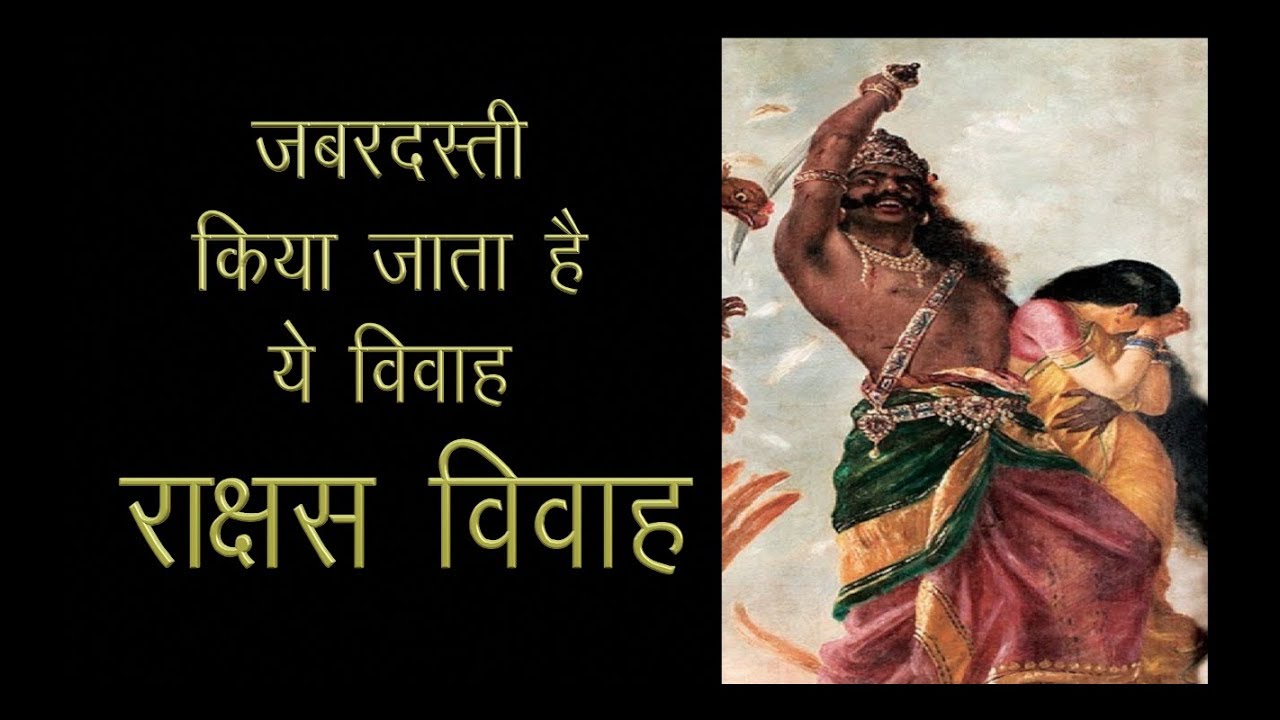By Editorial Staff

Rakshasa Vivah was described by Hindu scriptures as forceful seizure of a maiden from her home.
It is generally known that ancient Indian law recognized eight types of marriage; that is as follows:
1. Brahma Vivaha (Arranged M
arriage) : giving the girl to a man with dowry.
2. Daiva Vivaha: giving the girl to the priest himself in lieu of his fees.
3. Arsha Vivaha: giving the girl to a man after accepting a bride-price.
4. Prajapatya Vivaha: giving the girl to a man without demanding a bride-price.
5. Gandharva Vivaha: Love Marriage.
6. Asura Vivaha: marriage to a purchased girl.
7. Rakshava Vivaha: marriage to a kidnapped girl.
8. Paishacha Vivaha: marriage to a girl after seducing. (1)
I would like to concentrate here on the Rakshasa Vivaha and Paisacha Vivaha. Paishacha Vivah was the most horrible form of all types of marriages. In this the bride is not only kidnapped, but she is first molested or stolen amidst her tribe. Usually when her relatives are asleep, or in a state of intoxication during a tribal festival, this act is carried out in stealth. This form of marriage was most prevalent among the Hindu Sutras. The difference between the above mentioned forms of marriage as far as legal consequences are concerned exceedingly small. From the legal point of view, all forms of marriage could in principle be divided into orthodox forms of marriage (Brahma Vivaha, the Daiva Vivaha, the Arsa Vivaha, the Prjapatya Vivaha) and other forms of marriage (Asura Vivaha, Gandharva Vivahaa, Rakshasa Vivahaa and Paisacha Vivaha).
A marriage contracted according to one of the orthodox forms of marriage entails different legal consequences from a marriage contracted in other forms. In ancient India, the form of marriage (विवाह) signified in what way the marriage was contracted.(2)
Rakshasa Vivaha and Paisacha Vivaha are based on forcible abduction of a girl that has not consented to this marriage. According to Hindu scriptures, the forcible abduction is prohibited. But, if this forcible abduction is prohibited and considered a crime, how is it possible to admit a marriage based on forcible abduction was allowed? Of course it could not be allowed.
However, this form of marriage is recognized as unlawful probably for members of the Brahman caste only, but permissible for kings and Kshatriya caste.
Dr. Ludwik Sternbach presents many texts from the most important Hindu scriptures on the marriage by abduction in ancient India. He says in this regard: “I have based my conclusions upon the most important Dharmsastras, Arthasastras, Kamasutras, Grhyasutras and the Mahabharata and other Hindu scriptures.”(3)
Moreover, we find some Hindu scriptures praise abducting a girl for marriage, I am quoting here a passage by Johann Jakob Meyer who says in this regard:
“Not only Krishna, the conscienceless fellow, who rose to the lofty dignity of highest god from being an obscure new-comer, is set before us as a bold woman snatcher and not only the Arjuna so wrongly praised to the skies by later revisers of the Kuru saga, but also the truly noble Bhishma. Among his heroic deeds we often find the abduction of maidens, and when he is dead, his mother Ganga sings his praises for this too. Twice the Mahabharata tells the tale of how he carried off the daughter of the king of Kashi for his half-brother. In the first and very vivid passage we read: “When now Bhishma, wisest of the wise, saw that his brother had reached manhood’s years, he set his thoughts on finding him a wife. Then Bhishma heard how the three daughters of the king of Kashi (like the fairies of heaven they were) were all holding their choice of a husband.”(4) Until he lifted the maidens onto his chariot.
The abovementioned quote denotes clearly that abducting the girls of the king was regarded as a heroic deed and Bhishma has been regarded as the wisest of the wise.
On the contrary, Islam puts a harsh punishment for those who make mischief in the land and damage the security of the people.
The Glorious Qur’an says in this regard:
Indeed, the penalty for those who wage war against Allah and His Messenger and strive upon earth [to cause] corruption is none but that they be killed or crucified or that their hands and feet be cut off from opposite sides or that they be exiled from the land. That is for them a disgrace in this world; and for them in the Hereafter is a great punishment. (Al-Ma’idah 5:33)
However, the punishment is more serious if it is related to the woman. The one who accuses a chaste woman with false accusation is cursed by Allah, the Almighty, and angels in this world and the Hereafter. The Glorious Qur’an says:
Indeed, those who [falsely] accuse chaste, unaware and believing women are cursed in this world and the Hereafter; and they will have a great punishment. (An-Nur 24:23)
This punishment is prescribed by Allah, the Almighty, on just the accusation and slandering of a chaste woman, then how severe punishment would be for those who abduct a woman or terrorize her? I think if the punishment prescribed by Allah (glory be to Him) for adultery was implemented in modern societies accurately, there would be no rape at all that occurs daily in India and other countries of the world. It is really strange that Hindu scriptures praise the act of abducting a girl for marriage. Such nature is totally far from the spirit of a divine scripture.
It is really unreasonable that the marriage based on abducting or stealing a girl was allowed for kings and Kashtriya caste. It is surprising from the ancient Hindu law that allowed such unnatural marriage. How can we seek a reasonable cause for this type of injustice? Is it possible that a heavenly book may include such law? Allowing such marriage is an insult to the dignity of a woman by all standards. Such laws and principles can not be constituted by a wise man, not to mention Allah the Wise, the All-Knowing.
On the other hand, Islamic law never permits any marriage without the consent of the both parties; the bride and groom.
However, this type of marriage does not exist in India these days, perhaps it was before the advent of Islam, because the Islamic culture has left a significant impact on Indian culture and it reformed many Hindu religious ideologies and stereotypes, as well as, Islam has enlightened the religious thinking in India. For example, Islam was the active element in abolishing the tradition of Sati (a custom of burning the widow to death on her husband’s pyre). In the 16th century, steps to prohibit Sati were taken by the Mughal rulers Humayun and his son Akbar.(5) Thus Islam was a divine blessing even for Hindu women.
____________________
(1) http://gauravprakashspace.wordpress.com/2011/08/24/types-of-hindu-marriagevivaha/. Last accessed on 26-10-2013
(2) Ludwik Sternbach, Forms of Marriage in Ancient India And Their Development, Bharatiya Vidya, India, 1951, pp.63, 64.
(3) Ludwik Sternbach, Forms of Marriage in Ancient India And Their Development, Bharatiya Vidya, India, 1951, pp.63.
(4) Sexual Life in Ancient India, New York, Barnes & Noble, Inc. 1953, pp. 68, 69.
(5) http://www.britannica.com/EBchecked/topic/575795/suttee. Last accessed on 22-10-2013.
[opic_orginalurl]

